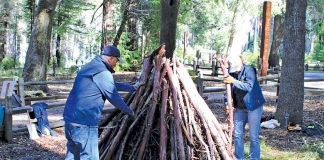I was riding one evening with four buddies just out of high school when the car went “bump” in the night. We all yelled, “What was that?” Jake, the driver, screamed, “It was a body.”
The brakes screeched, and our disparate responses to this tense situation could have been the subject of a doctoral dissertation in psychology.
Pressing himself into the back seat with a crazed look was a friend affectionately known as “The Ape” or “Apey.” He was yelling wildly, “I ain’t looking at no dead body.”
Next to me in the back seat was “Meaty,” making fun of Apey’s reaction.
Jake, meanwhile, was already out the door, sprinting back to help whoever had been hit.
“Sack,” in the passenger seat, was yelling after Jake not to touch the guy or he could be sued.
Meanwhile, I convinced Sack that we needed to support Jake, so we leapt out of the car while Meaty continued cracking tasteless jokes at Apey’s expense.
As we ran up, Jake was kneeling over what looked like a body. Jake’s body language, however, told me this was not human. It was a mannequin with a rope tied around it that stretched to the other side of the road. We quickly divined that some kids had placed the mannequin at the side of the road and yanked the body into the path of the car. We also knew we were being watched. What, after all, is the use of such a prank if you can’t see the reaction of the victims?
We yelled at Apey and Meaty, who had by now gotten into a full-fledged screaming match, to help us find the kids, who were likely hiding behind one of the fences just off the road.
Too late. Our shouts set the perpetrators running, as several sets of feet made a hasty retreat.
As we climbed back into the car, a discussion
ensued on whether one should act as a Good Samaritan, or if it was even legal to act as a Good Samaritan. Of course, our case was slightly different, since we had run over the victim in the first place. Still, we all came away with the feeling that the legal system discouraged people from acting altruistically.
Unfortunately, nothing in the law is simple. First, a person generally has no duty to go to the aid of another. But, if one does go to someone’s aid, he must exercise reasonable care — thus, a Good Samaritan who helps someone might be liable if he does not exercise reasonable care and ends up causing harm.
This was the overarching rule for many, many years. About 50 years ago, though, the Legislature decided to carve out an exception to the general rule whenever there is an emergency.
The Legislature wanted to encourage doctors or anyone else to help in an emergency, so it passed a law stating that there could be no civil liability for volunteers who provide emergency medical care in an emergency. (This doesn’t include emergency rooms or other places where medical care is usually offered.)
For many years, this was largely interpreted to mean that any volunteer who helps in any manner in an emergency is immune from liability. Then, the California Supreme Court stepped in.
In 2008, the court decided Van Horn v. Watson. In the case, a Good Samaritan pulled a woman out of a crashed car to safety. The hurt woman claimed that being pulled out of the car caused her to become a paraplegic. She argued that being pulled out of the car was not “emergency medical care,” so the Samaritan should not be protected.
The Supremes agreed. They stated that only emergency medical care got a free pass. Not so helpfully, they specifically declined to define what constitutes emergency medical care. One can readily imagine the confusion and concern this decision caused.
In response, the Legislature almost immediately amended the law. As the law stands, medical, law enforcement and emergency personnel are immune from civil liability if they provide either medical or “nonmedical” care at an emergency. For everyone else, like me, we’re immune from liability for providing medical or nonmedical care, as long as our acts don’t rise to the level of gross negligence or willful or wanton misconduct.
Remember, however, that we’re only talking about volunteers, here. There are different sets of rules for those who are paid to provide emergency services. As I always warn, these columns cannot explain all the permutations in the law.
This brings me to a hero in our midst. Those who know Tom Milnes know him as an outstanding history teacher at Scotts Valley Middle School. A while ago, some students burst out of a classroom in panic after a classmate went into what appeared to be cardiac arrest. Tom happened to be walking by the classroom at that instant. Without a second thought, he rushed to the student and performed CPR. Although I don’t know the student, I am informed that the student is now doing well but would have died had Tom not stepped in immediately.
I doubt any legalities were running through Tom’s head as he fought to save this student’s life. Still, it’s comforting
to know that the law encourages the heroic actions of Tom and every other Good Samaritan.
Gary Redenbacher of Scotts Valley is an attorney in private practice. Contact him at ga**@*********aw.com.










